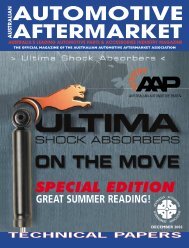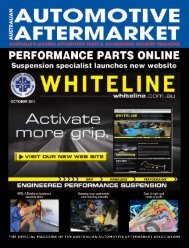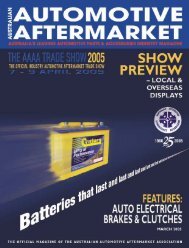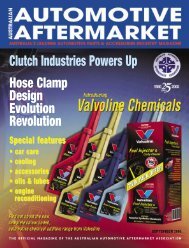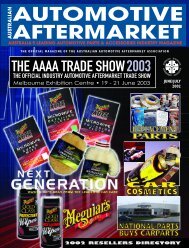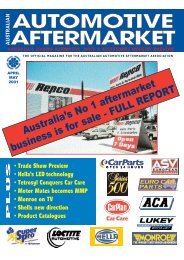AM MAGAZINE SHELL - Australian Automotive Aftermarket Magazine
AM MAGAZINE SHELL - Australian Automotive Aftermarket Magazine
AM MAGAZINE SHELL - Australian Automotive Aftermarket Magazine
You also want an ePaper? Increase the reach of your titles
YUMPU automatically turns print PDFs into web optimized ePapers that Google loves.
TECHNICAL PAPERS 2009<br />
The Development of<br />
Lokring<br />
In the early 1960s, a Swedish design<br />
engineer working at NASA designed an<br />
alternative to the welding of fuel lines.<br />
The concern with a weld is that unless<br />
X-rayed, there is no way to be sure<br />
that solder has penetrated and filled<br />
the gap between pipes fully and that<br />
there are no weakening bubbles<br />
hidden within.<br />
By designing a mechanical joint, these concerns were overcome. The Lokring system<br />
was not immediately employed however following a tragic accident with the APOLLO<br />
programme in the mid 1960’s, Lokring was re-assessed and implemented. It was during<br />
this time that the benefits of Lokring as a general tube joining system were realised<br />
and Vulkan, a German company established in the 1880’s, acquired the worldwide<br />
rights to Lokring as a joining solution to the refrigeration industry.<br />
The development of Applications<br />
• <strong>Automotive</strong> Manufacturers found Lokring to be a solution to joining aluminium tubes<br />
at evaporators in air conditioning systems. (1980)<br />
• Appliance manufacturers began using Lokring to join copper to aluminium and<br />
aluminium to aluminium. (1981)<br />
• European service companies started using Lokring for service due to the<br />
implementation initially of R134a (because of need for inner tube cleanliness and<br />
small molecular size of refrigerant) and ultimately R600a as a refrigerant. Service<br />
Lokrings and tooling were developed.<br />
• <strong>Automotive</strong> AC technicians began using Lokring to join aluminium tubes on vehicles.<br />
( 1995 – GM were the first OEM to approve and implement LOKRING) This led to<br />
the development of a large range of fittings with Lokring as a base.<br />
• Larger sizes (up to 35mm) were developed and found application in the HVAC field.<br />
The cleanliness of the Lokring system did not require the purging of nitrogen during<br />
pipe installation. The evolution of OH&S requirements such as Hot Work Permits<br />
and other constraints involved in the welding process has seen this market expand.<br />
In 2009 there are more than 1.2 billion Lokrings in service. Last year more than<br />
120 million Lokrings were installed.<br />
How does it Work<br />
Vulkan Industries Far East Pte Ltd<br />
12 Wollong St, Gosford, NSW 2250<br />
Ph 02 4322 8533 Fax 02 4322 8599<br />
www.vulkan.com.au<br />
info@vulkan.com.au<br />
A cutaway showing a typical<br />
alloy to alloy connection<br />
A typical automotive Lokring service connector consists of four separate components;<br />
one joint, two Lokrings and an anaerobic solution called Lokprep. Lokprep is added to<br />
the outside of the tubes which are then inserted into the union joint. Using the Lokring<br />
hand tool, the Lokrings are forced over the joint which in turn is down-swaged onto the<br />
tube. A hermetic metal-to-metal seal is made by this compression with the Lokprep<br />
accounting for any longitudinal imperfections in the tube surface.<br />
• Taper A is a leading edge that enables the Lokring to be forced onto the joint.<br />
• Taper B is the sealing area. Somewhere along this taper the tube is compressed to<br />
32 AU T O M O T I V E A F T E R M A R K E T M AG A Z I N E D E C E M B E R 2 0 0 9 www.aaaa.com.au



